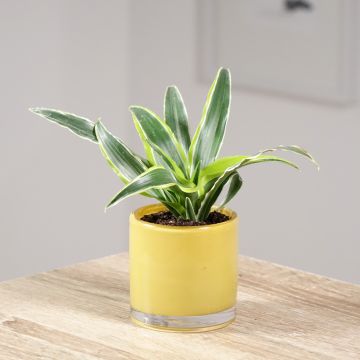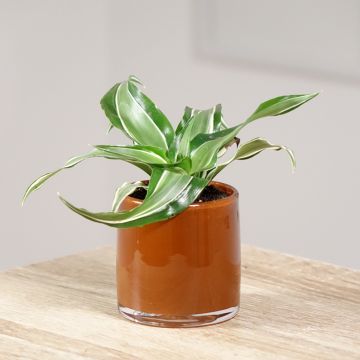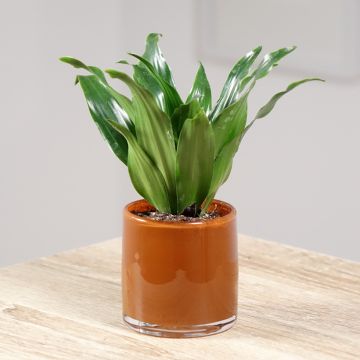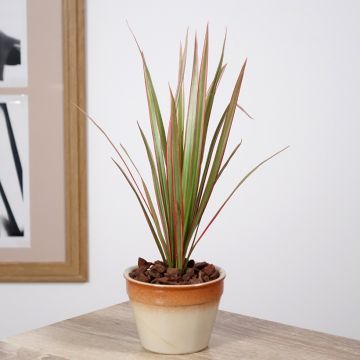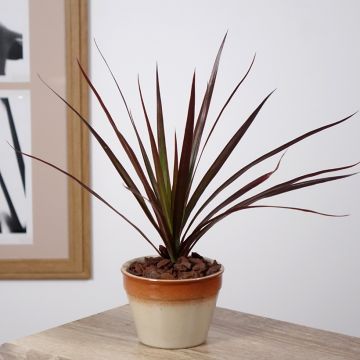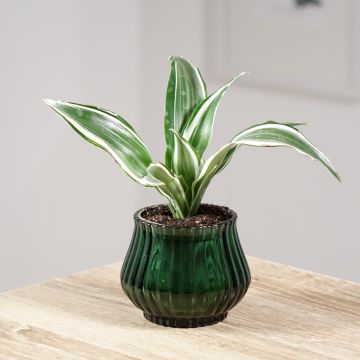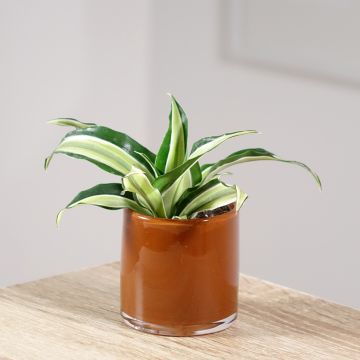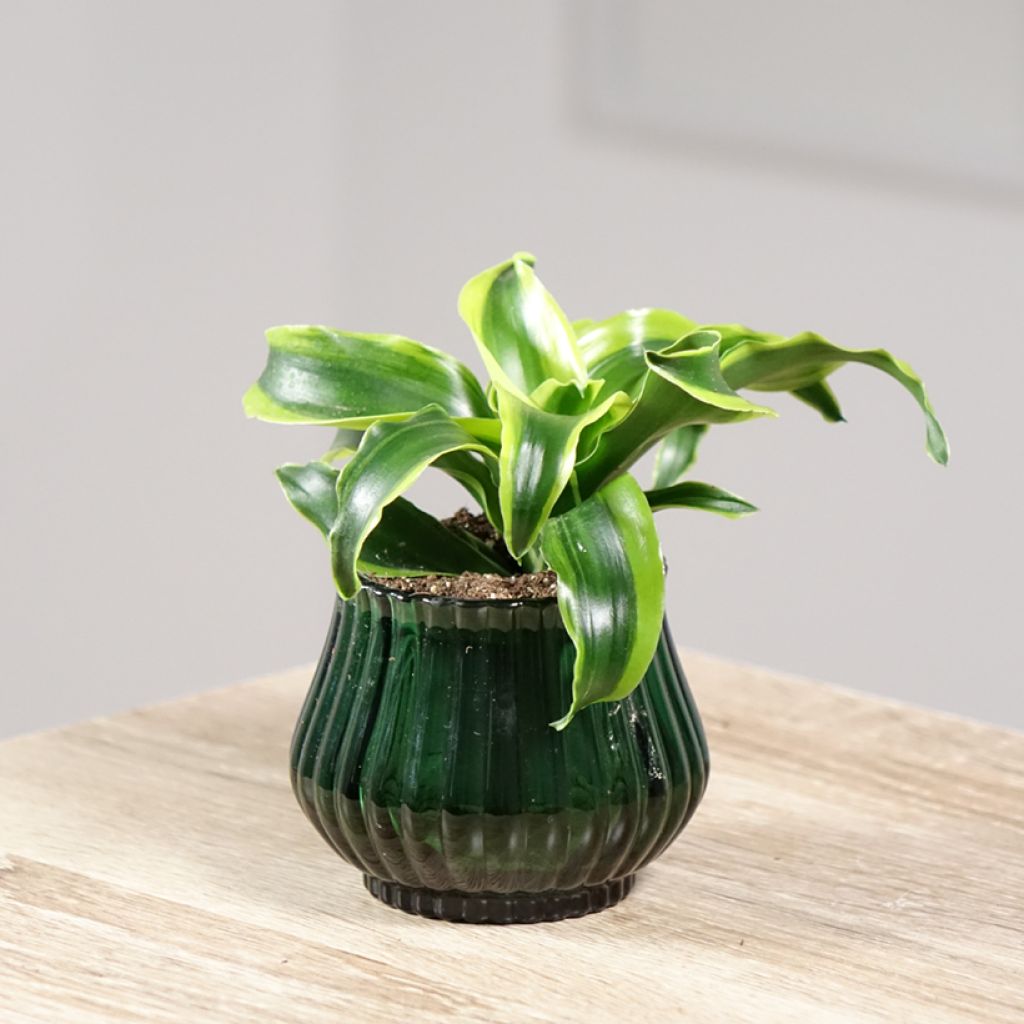

Dracaena fragrans Dragontree Tornado - Dragon tree
Dracaena fragrans Dragontree Tornado - Dragon tree
Dracaena fragrans Dragontree Tornado
Dragon tree
Very pretty plant with shiny leaves and a graceful movement... It looks like it's dancing... Received last week... We'll see how it adapts to my home. I'll make sure to pamper it...
Beatrice , 02/06/2025
Special offer!
Receive a €20 voucher for any order over €90 (excluding delivery costs, credit notes, and plastic-free options)!
1- Add your favorite plants to your cart.
2- Once you have reached €90, confirm your order (you can even choose the delivery date!).
3- As soon as your order is shipped, you will receive an email containing your voucher code, valid for 3 months (90 days).
Your voucher is unique and can only be used once, for any order with a minimum value of €20, excluding delivery costs.
Can be combined with other current offers, non-divisible and non-refundable.
Home or relay delivery (depending on size and destination)
Schedule delivery date,
and select date in basket
This plant carries a 30 days recovery warranty
More information
We guarantee the quality of our plants for a full growing cycle, and will replace at our expense any plant that fails to recover under normal climatic and planting conditions.
Description
The Dracaena fragrans 'Dragontree Tornado' (synonym Dracaena deremensis 'Dragontree Tornado') stands out from other indoor Dragon Trees due to the originality of its foliage, which gives it its variety name. The sword-shaped leaves grow in a spiral and curve both vertically and laterally, creating the impression of a tornado's rotational movement. This unique design is complemented by a colour combination that is both contrasting and harmonious, blending dark green edged with a lighter lime green that verges on yellow. As attractive as it is easy to grow in most indoor settings, this Dragon Tree is a true living sculpture that draws all eyes in the home.
The Dracaena has moved through botanical classifications from one family to another before being integrated into the Asparagaceae. Named after the asparagus, the family hosts many highly diverse ornamental genera such as Ophiopogons, Agaves, or Lily of the Valley. There are dozens of Dracaena species, primarily distributed across Africa and Southeast Asia, with smaller populations in Central America, China, or Australia... The Dracaena fragrans, sometimes called Cordyline fragrans, grows in tropical Africa from the coast up to 1,500 m altitude. In lowland areas, it forms dense stands in dry forests, developing into bushes that can reach 6 m in height. They are typically sparsely branched, producing herbaceous or semi-woody stems 2.5 to 10 cm in diameter, bearing clusters of long, narrow leaves ranging from 30 cm to 1 m in length. The bush produces large inflorescences (up to 60 cm long), formed of small white-yellow flowers that open at night, releasing a strong fragrance. The orange to red fruiting consists of small berries 1.5 to 2 cm in diameter.
The 'Dragontree Tornado' is a horticultural variety that looks quite different from the wild type species. With moderate to slow growth, especially if light levels are somewhat low, this compact Dragon Tree will eventually reach a mature height of just 90 cm to 1.20 m, with a spread of around 50 cm. Suitable even for the most compact indoor spaces, it is decorative from a young age, forming a clump that appears to twist in all directions. The sheathing leaves are imbricate at the base, arranged in an ascending spiral, then unfurl while curving downward and sideways. This original arrangement gives the variety its distinctive character. The lanceote leaves appear shorter than those of other Dragon Trees due to their curvature, creating a remarkable three-dimensional silhouette. Additionally, they are bicoloured, featuring a dark green central band bordered on either side by a broad lime-green to yellow-green margin. Over the years, the layers of leaves stack up as they ascend, and the plant eventually forms a slender vertical axis supporting the tuft of leaves. Flowering is virtually unknown indoors, but the plant's beauty more than compensates for that absence.
To top it off, this Dragon Tree is very accommodating in cultivation, adapting to bright light (though not direct sunlight) as well as more subdued lighting, and it thrives with a minimum humidity of 40% while tolerating much higher levels. It is an ideal plant for beginners, the only caution being not to overwater it—especially avoiding watering inside the leaves, which could cause them to rot at the base (aim for the compost at the base instead).
With its striking design and cheerful colours, the Dragon Tree 'Dragontree Tornado' is a little indoor gem within everyone's reach. Its glossy, swirling foliage almost makes you forget that it is a living being and not a sculpture! Perfect in a contemporary setting, you can pair it with other highly distinctive plants like the Beaucarnea recurvata, or Bottle Tree, whose swollen base supporting a tuft of trailing strap-like leaves is equally spectacular. Bromeliads such as the ornamental Pineapple or Guzmania also hold their own in terms of design, with their typical rosette leaves and often dazzling blooms.
Report an error about the product description
Foliage
Plant habit
Botanical data
Dracaena
fragrans
Dragontree Tornado
Asparagaceae
Dragon tree
Cultivar or hybrid
Other Dracaena - Dragon Tree
View all →Location
Location
Maintenance and care
Watering tips
Potting advice, substrates and fertilisers
Houseplant care
Disease and pest advice
Maintenance and care
-
, onOrder confirmed
Reply from on Promesse de fleurs
Haven't found what you were looking for?
Hardiness is the lowest winter temperature a plant can endure without suffering serious damage or even dying. However, hardiness is affected by location (a sheltered area, such as a patio), protection (winter cover) and soil type (hardiness is improved by well-drained soil).

Photo Sharing Terms & Conditions
In order to encourage gardeners to interact and share their experiences, Promesse de fleurs offers various media enabling content to be uploaded onto its Site - in particular via the ‘Photo sharing’ module.
The User agrees to refrain from:
- Posting any content that is illegal, prejudicial, insulting, racist, inciteful to hatred, revisionist, contrary to public decency, that infringes on privacy or on the privacy rights of third parties, in particular the publicity rights of persons and goods, intellectual property rights, or the right to privacy.
- Submitting content on behalf of a third party;
- Impersonate the identity of a third party and/or publish any personal information about a third party;
In general, the User undertakes to refrain from any unethical behaviour.
All Content (in particular text, comments, files, images, photos, videos, creative works, etc.), which may be subject to property or intellectual property rights, image or other private rights, shall remain the property of the User, subject to the limited rights granted by the terms of the licence granted by Promesse de fleurs as stated below. Users are at liberty to publish or not to publish such Content on the Site, notably via the ‘Photo Sharing’ facility, and accept that this Content shall be made public and freely accessible, notably on the Internet.
Users further acknowledge, undertake to have ,and guarantee that they hold all necessary rights and permissions to publish such material on the Site, in particular with regard to the legislation in force pertaining to any privacy, property, intellectual property, image, or contractual rights, or rights of any other nature. By publishing such Content on the Site, Users acknowledge accepting full liability as publishers of the Content within the meaning of the law, and grant Promesse de fleurs, free of charge, an inclusive, worldwide licence for the said Content for the entire duration of its publication, including all reproduction, representation, up/downloading, displaying, performing, transmission, and storage rights.
Users also grant permission for their name to be linked to the Content and accept that this link may not always be made available.
By engaging in posting material, Users consent to their Content becoming automatically accessible on the Internet, in particular on other sites and/or blogs and/or web pages of the Promesse de fleurs site, including in particular social pages and the Promesse de fleurs catalogue.
Users may secure the removal of entrusted content free of charge by issuing a simple request via our contact form.
The flowering period indicated on our website applies to countries and regions located in USDA zone 8 (France, the United Kingdom, Ireland, the Netherlands, etc.)
It will vary according to where you live:
- In zones 9 to 10 (Italy, Spain, Greece, etc.), flowering will occur about 2 to 4 weeks earlier.
- In zones 6 to 7 (Germany, Poland, Slovenia, and lower mountainous regions), flowering will be delayed by 2 to 3 weeks.
- In zone 5 (Central Europe, Scandinavia), blooming will be delayed by 3 to 5 weeks.
In temperate climates, pruning of spring-flowering shrubs (forsythia, spireas, etc.) should be done just after flowering.
Pruning of summer-flowering shrubs (Indian Lilac, Perovskia, etc.) can be done in winter or spring.
In cold regions as well as with frost-sensitive plants, avoid pruning too early when severe frosts may still occur.
The planting period indicated on our website applies to countries and regions located in USDA zone 8 (France, United Kingdom, Ireland, Netherlands).
It will vary according to where you live:
- In Mediterranean zones (Marseille, Madrid, Milan, etc.), autumn and winter are the best planting periods.
- In continental zones (Strasbourg, Munich, Vienna, etc.), delay planting by 2 to 3 weeks in spring and bring it forward by 2 to 4 weeks in autumn.
- In mountainous regions (the Alps, Pyrenees, Carpathians, etc.), it is best to plant in late spring (May-June) or late summer (August-September).
The harvesting period indicated on our website applies to countries and regions in USDA zone 8 (France, England, Ireland, the Netherlands).
In colder areas (Scandinavia, Poland, Austria...) fruit and vegetable harvests are likely to be delayed by 3-4 weeks.
In warmer areas (Italy, Spain, Greece, etc.), harvesting will probably take place earlier, depending on weather conditions.
The sowing periods indicated on our website apply to countries and regions within USDA Zone 8 (France, UK, Ireland, Netherlands).
In colder areas (Scandinavia, Poland, Austria...), delay any outdoor sowing by 3-4 weeks, or sow under glass.
In warmer climes (Italy, Spain, Greece, etc.), bring outdoor sowing forward by a few weeks.






























